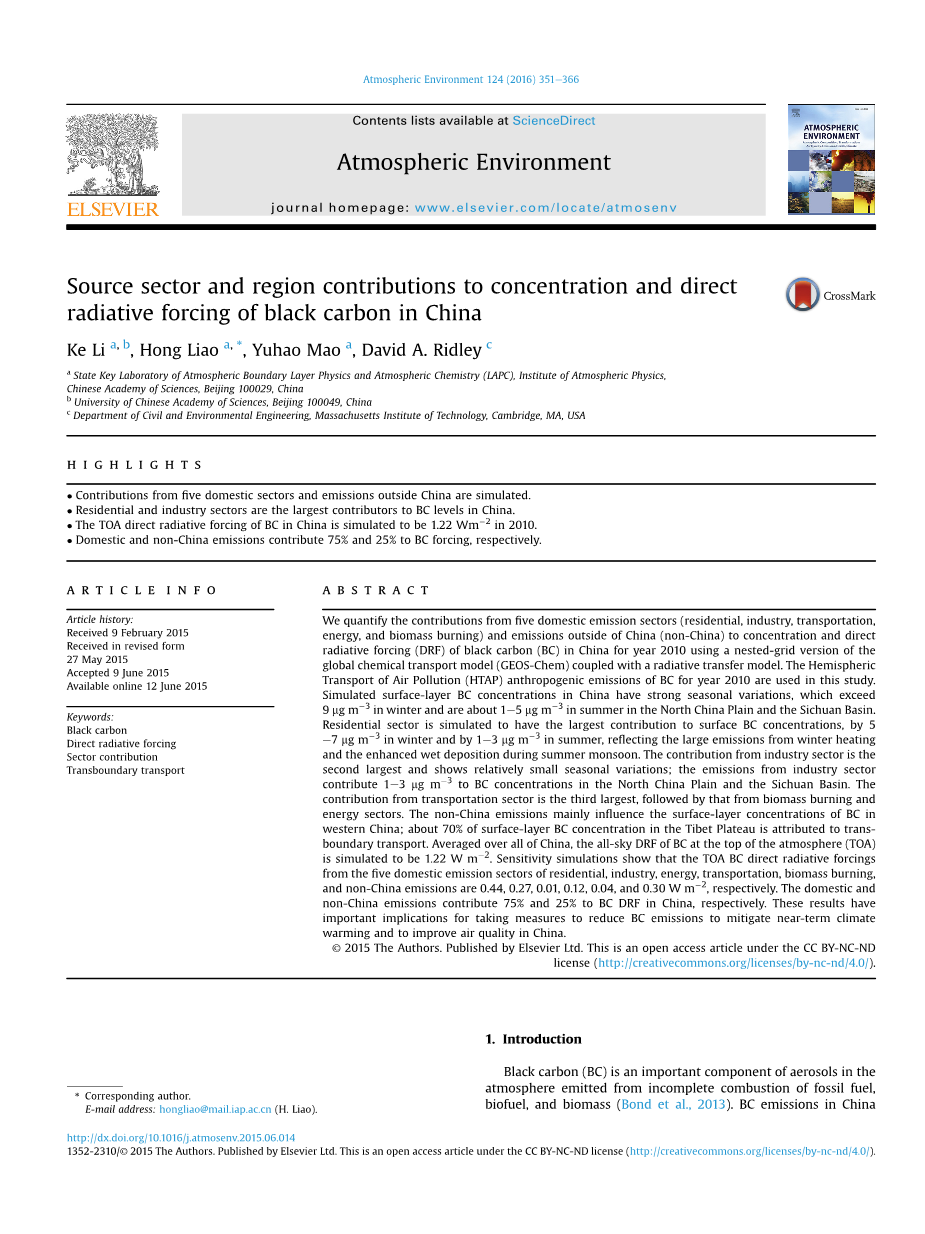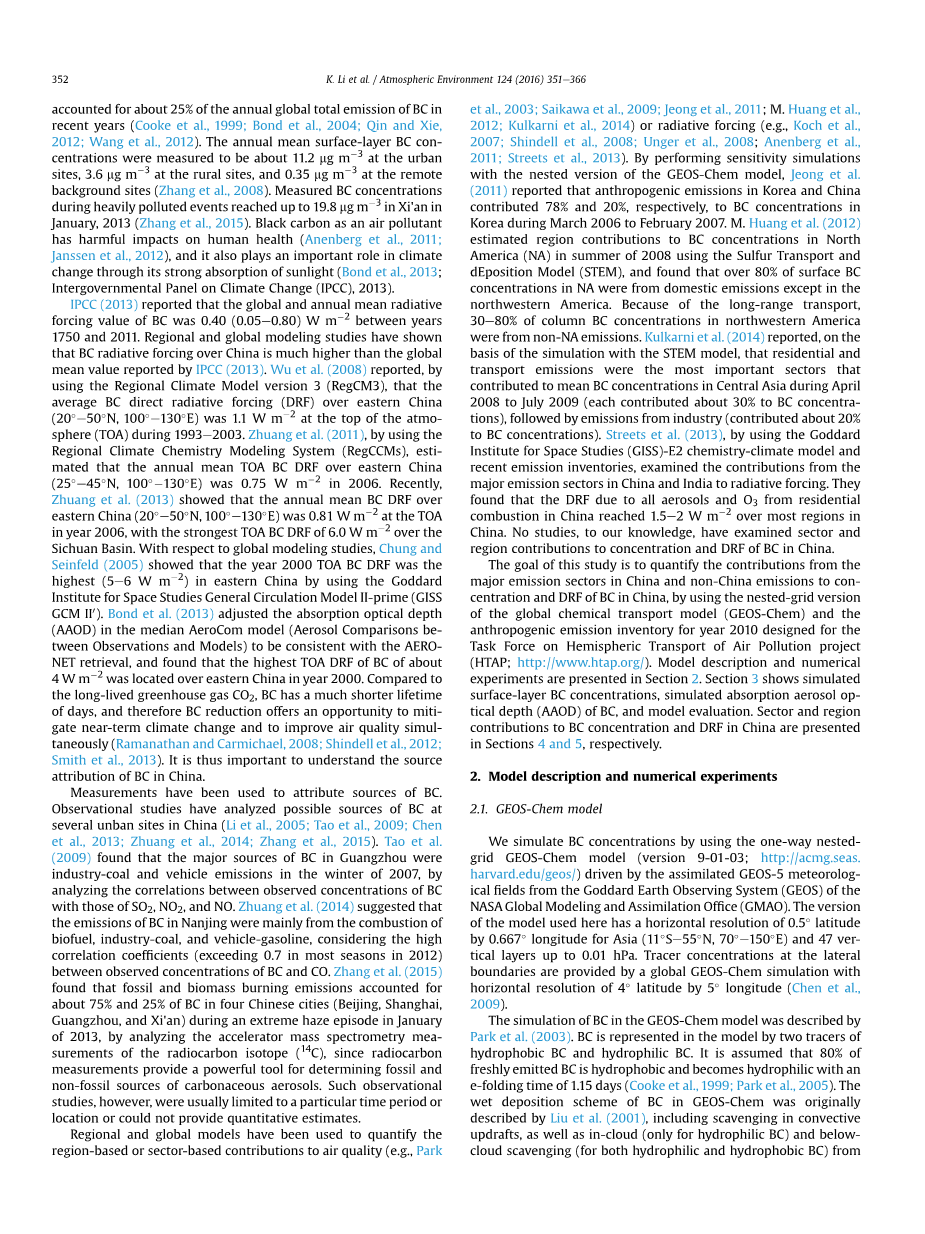英语原文共 16 页,剩余内容已隐藏,支付完成后下载完整资料
不同行业及地区对中国黑碳浓度及其直接辐射强迫的贡献分析
李珂1,2,廖宏1,*,茅予豪1,David A. Ridley3
- 中国科学院大气物理研究所大气边界层物理与大气化学国家重点实验室(LAPC), 北京100029;2.中国科学院大学,北京100049;3.美国马萨诸塞州剑桥市马萨诸塞理工学院土木与环境工程系)
摘要 本文将全球化学运输模型(GEOS-Chem)的网格嵌入式版与辐射传输模型相结合,具体计算了国内不同行业排放源(民用,工业,交通,能源和生物质燃烧)和非国内排放源对中国2010年黑碳(BC)浓度及其直接辐射强迫值的贡献。本研究使用了2010年半球空气污染(HTAP)黑碳(BC)的人为排放值。模拟结果表明,中国地表黑碳(BC)浓度的模拟值季节变化较大,在华北平原和四川盆地,冬季模拟值超过9mu;g m-3 ,夏季模拟值大约为1-5mu;g m-3 。民用排放是地表BC浓度模拟值的最大贡献源,冬季为5-7mu;g m-3 ,夏季为1-3mu;g m-3 ,反映了冬季加热供暖产生的大量排放与夏季季风期间增强的湿沉积效应。工业排放是第二大贡献源,表现出相对较小的季节变化;其模拟值在华北平原和四川盆地的贡献为1-3mu;g m-3 。交通排放贡献居第三位,其次分别是生物质燃烧和能源排放。非国内排放源主要影响中国西部黑碳(BC)的地表浓度;青藏高原地表黑碳(BC)浓度约为70%,可归因于越境运输。中国地区平均而言,黑碳(BC)在大气层顶的全天直接辐射强迫模拟值为1.22Wm-2。敏感性实验表明,国内不同行业排放源(民用,工业,交通、能源和生物质燃烧)以及非国内排放源所引起的大气层顶黑碳直接辐射强迫值(TOA BC DRF)分别为0.44,0.27,0.01,0.12, 0.04和0.30Wm-2。在中国,国内排放和非中国排放对黑碳的直接辐射强迫值的贡献分别为75%和25%。这些结果对采取黑碳减排措施,以期缓解近期气候变暖和改善中国空气质量具有重要意义。
关键词 黑碳;直接辐射强迫;行业贡献;越境运输
文章编号 中图分类号 文献标识码
doi:
Source sector and region contributions to concentration and direct radiative forcing of black carbon in China
Ke Li a, b, Hong Liao a, *, Yuhao Mao a, David A. Ridley c
- State Key Laboratory of Atmospheric Boundary Layer Physics and Atmospheric Chemistry (LAPC), Institute of Atmospheric Physics, Chinese Academy of Sciences, Beijing 100029, China
- University of Chinese Academy of Sciences, Beijing 100049, China
- Department of Civil and Environmental Engineering, Massachusetts Institute of Technology, Cambridge, MA, USA
Abstract We quantify the contributions from five domestic emission sectors (residential, industry, transportation, energy, and biomass burning) and emissions outside of China (non-China) to concentration and direct radiative forcing (DRF) of black carbon (BC) in China for year 2010 using a nested-grid version of the global chemical transport model (GEOS-Chem) coupled with a radiative transfer model. The Hemispheric Transport of Air Pollution (HTAP) anthropogenic emissions of BC for year 2010 are used in this study. Simulated surface-layer BC concentrations in China have strong seasonal variations, which exceed 9 mg m 3 in winter and are about 1e5 mg m 3 in summer in the North China Plain and the Sichuan Basin. Residential sector is simulated to have the largest contribution to surface BC concentrations, by 5 e7 mg m 3 in winter and by 1e3 mg m 3 in summer, reflecting the large emissions from winter heating and the enhanced wet deposition during summer monsoon. The contribution from industry sector is the second largest and shows relatively small seasonal variations; the emissions from industry sector contribute 1e3 mg m 3 to BC concentrations in the North China Plain and the Sichuan Basin. The contribution from transportation sector is the third largest, followed by that from biomass burning and energy sectors. The non-China emissions mainly influence the surface-layer concentrations of BC in western China; about 70% of surface-layer BC concentration in the Tibet Plateau is attributed to trans-boundary transport. Averaged over all of China, the all-sky DRF of BC at the top of the atmosphere (TOA) is simulated to be 1.22 W m 2. Sensitivity simulations show that the TOA BC direct radiative forcings from the five domestic emission sectors of residential, industry, energy, transportation, biomass burning, and non-China emissions are 0.44, 0.27, 0.01, 0.12, 0.04, and 0.30 W m 2, respectively. The domestic and non-China emissions contribute 75% and 25% to BC DRF in China, respectively. These results have important implications for taking measures to reduce BC emissions to mitigate near-term climate warming and to improve air quality in China.
Keywords Black carbon, Direct radiative forcing, Sector contribution, Transboundary transport
1 引言
黑碳(BC)是化石燃料,生物燃料和生物质不完全燃烧生成的含碳颗粒物,是大气气溶胶的重要组分(Bond等人,2013)。近年来,中国BC年排放量约占全球BC年总排放量的25%(Cooke等,1999; Bond等,2004; Qin和Xie,2012; Wang等,2012)。城市地区地表BC浓度的年平均观测值为11.2mu;g m-3 ,农村地区为3.6mu;g m-3 ,偏远背景地区为0.35mu;g m-3 (Zhang et al.,2008 )。 2013年1月西安重度污染事件中,BC浓度监测值达到19.8mu;g m-3 (Zhang et al.,2015)。 BC作为空气污染物,危害人体健康(Anenberg等,2011; Janssen等,2012),且通过对阳光的强烈吸收,在气候变化中起着重要作用(Bond等, 2013;政府间气候变化专门委员会(IPCC),2013年)。
IPCC(2013)报告指出,从1750年至2011年,BC辐射强迫的全球年平均值为0.40(0.05-0.80)Wm-2。区域和全球模拟研究表明,中国BC的辐射强迫值远高于IPCC报告中的全球平均值(2013年)。 Wu et al (2008)使用区域气候模式第3版(RegCM3)指出,1993-2003年,华东地区(20°- 50°N,100°- 130°E)大气层顶(TOA)BC直接辐射强迫(DRF)的平均值为1.1Wm-2。 Zhuang et al. (2011),使用区域气候化学模拟系统(RegCCMs)估计,2006年华东地区(25°- 45°N,100°- 130°E)TOA BC DRF年平均值为0.75Wm-2。近期 Zhuang et al. (2013年)研究显示,2006年华东地区(20°- 50°N,100°- 130°E)TOA BC DRF年平均值为0.81Wm-2,四川盆地TOA BC DRF年平均值最高,为6.0 Wm-2。关于全球模拟研究,Chung和Seinfeld(2005)使用戈达德空间研究所通用循环模型II-prime(GISS GCM II0)表明,2000年华东地区的TOA BC DRF值最高(5-6Wm-2 )。 Bond et al. (2013)调整了中值AeroCom模型(气溶胶观测值与模拟值的比较)中吸收光学厚度(AAOD),使其与AERO-NET监测值一致,发现BC的TOA DRF最高值约为4Wm-2,出现在2000年的华东地区。与具有较长寿命的温室气体CO2相比,BC的生命周期较短,因此,BC减排为缓和近期气候变化和改善空气质量提供了机会。(Ramanathan和Carmichael,2008; Shindell等,2012; Smith等,2013)。故了解BC在中国的来源归属具有重要意义。
已观测BC来源贡献。观测研究分析了中国几个城市站点BC的可能来源(Li et al.,2005; Tao et al.,2009; Chen et al.,2013; Zhuang et al.,2014; Zhang et al.,2015)。 Tao et. al(2009)通过分析BC浓度观测值与SO2,NO2和NO浓度观测值之间的相关性发现,2007年冬季广州工业煤和车辆排放是BC的主要贡献源。 Zhuang et al.(20
剩余内容已隐藏,支付完成后下载完整资料
资料编号:[27666],资料为PDF文档或Word文档,PDF文档可免费转换为Word
课题毕业论文、外文翻译、任务书、文献综述、开题报告、程序设计、图纸设计等资料可联系客服协助查找。




